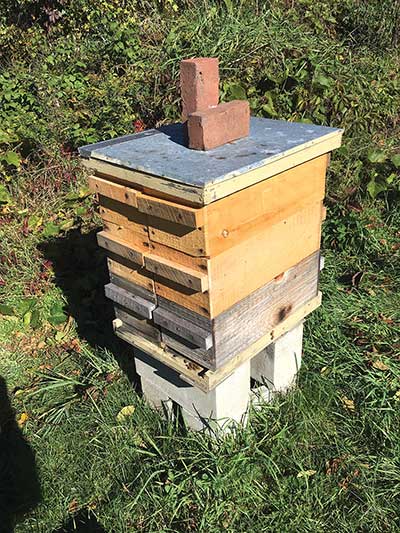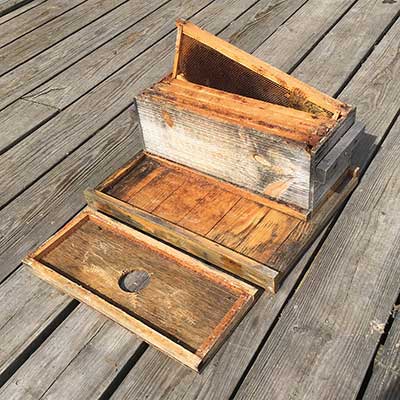 |
| Photo 1 – A complete, two-queen, side-by-side hive. Each side is a stack of three four-frame medium boxes. Entrances to the hives are on opposite ends, minimizing drift of bees from one box to its neighbor. |
 |
| Photo 2 – Hive components specific to a two-queen, side-by-side, four-frame hive shown from front to back: an inner cover, a divided bottom board and a four-frame medium box with four medium frames. |
By Jonathan Mitschele
Photos by the author
A heavy problem for most backyard beekeepers, especially those of a certain age, is the 50- to 90-pound weight of a full box of honey. A beehive often is a stack of three, four or more of these boxes, and a few times each summer beekeepers have to lift off one or more of the boxes in the stack to get to one that needs attention. That means lifting some or all of the boxes above the bottom box, doing what needs to be done, and then reassembling the whole thing. That’s a lot of heavy lifting!
I recommend a different way to keep bees – one in which each box in a hive weighs no more than 25 pounds and usually less. I call my setup a two-queen, side-by-side hive. Each side of such a hive is a stack of four-frame medium boxes, and each side houses a complete bee colony, with a queen, worker bees and, for much of the summer, drones. Photo 1 shows a complete hive setup, with three medium boxes on each side, and photo 2 shows the components specific to such a hive.
These are the advantages of my setup:
- A full, four-frame medium box weighs no more than 25 pounds and is much easier to handle than eight- or 10-frame hive boxes.
- With only four medium frames per box, finding things – the queen, for example – is easier because the medium frames have about one-third less area than deep frames, and each box has only four, not eight or 10, frames.
- Winter survival is excellent. Each four-frame medium box has less than half the volume of an eight- or 10-frame medium box to keep warm. A smaller volume also means less chance for the winter cluster of bees to move into a corner of the hive that has no honey. When this happens in a standard hive, it may be too cold for the cluster to move to where there is honey, and the colony starves to death.
- I overwinter hives successfully with three medium boxes on each side, using fewer resources than those recommended for overwintering in 10-frame hives.
- Varroa mites seem to be less problematic with my four-frame hives than with my 10-frame hives.
- My double hives use standard outer covers and easily modified standard bottom boards, minimizing the need to buy new equipment.
- Hive construction is very simple and requires only lumber, a table saw, a routing blade, a drill and drill bits, a screwdriver and screws.
- A two-queen hive will produce more honey than two single-queen hives. An issue with vertical two-queen hives, in which one bee colony is placed on top of a second colony with a queen excluder between the two colonies, is the occasional need to get into the bottom hive. This means taking everything off of the hive on the bottom and then reassembling everything. With two-queen hives, I can access either side without disturbing the other side.
- For honey production, a beekeeper can add medium boxes in pairs or can put a queen excluder over the uppermost pair of medium boxes and add 10-frame medium boxes above the excluder. The bees from both sides of the hive will work amicably together to fill the 10-frame boxes with honey.
My friend Matt Olson of Casco, Maine (207-615-8246, [email protected]), makes the hive components I use.
About the author: Jonathan keeps bees in New Gloucester, Maine.

